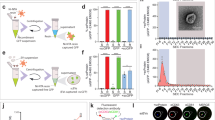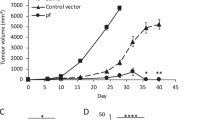Abstract
Fusogenic liposomes (virosomes) consisting of Sendai virus envelope proteins have been utilized for in vitro and in vivo genetic modification of animal cells. In this study, the virosomes containing DNA were prepared by quantitative reconstitution of Sendai envelope proteins, fusion protein and hemagglutinin–neuramindase in liposomal vesicles. The Sendai virosomes more efficiently transferred genes into cultured 293 transformed kidney cells than 1,2-dioleoyl-3-(trimethylammonium) propane–based cationic liposomes. At 200:1 weight ratio of envelope protein and lipid, the virosomes exhibited the best efficiency of gene transfection into the cells. The Sendai virosomes required relatively a short period of incubation time and much less cytotoxic, compared to the cationic liposome/DNA complex. The transfection efficiency of the Sendai virosomes containing DNA was maintained 70% after a month. This type of Sendai virosomes is relatively convenient for preparation and storage, compared to fusogenic liposomes prepared by liposome–virus fusion. First of all, because the constituents are quantitatively formulated, this type of virosome formulation can provide further consistent transfection for gene therapy.
This is a preview of subscription content, access via your institution
Access options
Subscribe to this journal
Receive 12 print issues and online access
$259.00 per year
only $21.58 per issue
Buy this article
- Purchase on Springer Link
- Instant access to full article PDF
Prices may be subject to local taxes which are calculated during checkout




Similar content being viewed by others
References
Salmons B, Gunzburg WH . Targeting of retroviral vectors for gene therapy Hum Gene Ther 1993 4: 129–141
Felgner JH, Kumar R, Sridhar CN et al. Enhanced gene delivery and mechanism studies with novel series of cationic lipid formulations J Biol Chem 1994 269: 2550–2561
Gao X, Huang L . A novel cationic liposome reagent for efficient transfection of mammalian cells Biochem Biophys Res Commun 1991 179: 280–285
Gao X, Huang L . Potentiation of cationic liposome-mediated gene delivery by polycations Biochemistry 1996 35: 1027–1036
Cho JE, Kim HS, Ahn WS, Park YS . Enhanced cytotoxicity of doxorubicin encapsulated in liposomes with reconstituted Sendai F-proteins J Microencapsulation 2001 18: 421–431
Nakanishi M, Uchida T, Kim J, Okada Y . Glycoproteins of Sendai virus (HVJ) have a critical ratio for fusion between virus envelopes and cell membranes Exp Cell Res 1982 142: 95–101
Mizuguchi H, Nakagawa T, Nakanishi M, Imazu S, Nakagawa S, Mayumi T . Efficient gene transfer into mammalian cells using fusogenic liposome Biochem Biophys Res Com 1996 218: 402–407
Bagai S, Puri A, Blumenthal R, Sarkar DP . Hemagglutinin–neuraminidase–enhanced F protein–mediated membrane fusion of reconstituted Sendai virus envelopes with cells J Virol 1993 67: 3312–3318
Tomasi M, Lotyter A . Selective extraction of biologically active F-glycoprotein from dithiothreitol reduced Sendai virus particles FEBS Lett 1981 131: 381–385
Bradford M . A rapid and sensitive method for quantitation of microgram quantities of protein utilizing the principle of protein–dye binding Anal Biochem 1976 72: 248–254
Sechoy O, Philippot JR, Bienvenue A . Preparation and characterization of F protein vesicles isolated from Sendai virus by means of octylglucoside Biochem Biophys Acta 1986 857: 1–12
Vainstein A, Hershkovitz M, Israel S, Rabin S, Loyter A . A new method for reconstitution of highly fusogenic Sendai virus envelopes Biochem Biophys Acta 1984 773: 184–188
Philippot J, Mutaftschiev S, Liauturd JR . A very mild method allowing the encapsulation of very high amounts of macromolecules into very large (1000 nm) unilamellar liposomes Biochem Biophys Acta 1983 734: 137–143
Chalfie M, Tu Y, Euskirchem G, Ward WW, Prasher DC . Green fluorescent protein as a marker for gene expression Science 1984 263: 802–805
Miller CR, Boudurant B, McLean SD, McGovern KA, O'Brien DF . Liposome–cell interaction in vitro: effects of liposome-surface charge on the binding and endocytosis of conventional and sterically stabilized liposomes Biochemistry 1998 37: 12875–12883
McLachan G, Davidson H, Davidson P, Dorin J, Porteous D . DOTAP as a vehicle for efficient gene delivery in vitro and in vivo Biochimica 1994 11: 19–21
Komai R, Roops B, Mukesh K, Sandeep KT, Debi DS . Novel gene delivery to liver cells using engineered virosomes FEBS Lett 1997 404: 164–168
Al-Ahdal MN, Abidi TF, Flanagan TD . The interaction of Sendai virus glycoprotein-bearing recombinant vesicles with cell surface Biochem Biophys Acta 1986 854: 157–168
Yanovsky A, Loyter A . The mechanism of cell fusion J Biol Chem 1972 247: 4021–4028
Bagai S, Sarkar DP . Fusion-mediated microinjection of lysozyme into HepG2 cells through hemagglutinin neuraminidase–depleted Sendai virus envelopes J Biol Chem 1994 369: 1966–1972
Hoekstra D, Boer TD, Klappe K, Wilschut J . Fluorescence method for measuring the kinetics of fusion between biological membranes Biochemistry 1984 23: 5675–5681
Maeda T, Asano A, Ohki K, Okada Y, Ohnishi SI . A spin-label study on fusion of red blood cells induced by hemagglutinating virus of Japan Biochemistry 1975 14: 3736–3741
Hoekstra D, Klappe K . Sendai virus–erythrocyte membrane interaction: quantitative and kinetic analysis of viral binding, dissociation and fusion J Virol 1986 58: 87–95
Henis YI, Gutman O, Loyter A . Sendai virus envelope glycoproteins become laterally mobile on the surface of human erythrocyte following fusion Exp Cell Res 1985 160: 514–526
Acknowledgements
The authors acknowledge the financial support of the Korea Ministry of Commerce, Industry, and Energy made in the program year of 2000.
Author information
Authors and Affiliations
Corresponding author
Rights and permissions
About this article
Cite this article
Kim, H., Park, Y. Gene transfection by quantitatively reconstituted Sendai envelope proteins into liposomes. Cancer Gene Ther 9, 173–177 (2002). https://doi.org/10.1038/sj.cgt.7700421
Received:
Published:
Issue Date:
DOI: https://doi.org/10.1038/sj.cgt.7700421
Keywords
This article is cited by
-
An efficient liposomal gene delivery vehicle using Sendai F/HN proteins and protamine
Cancer Gene Therapy (2008)



